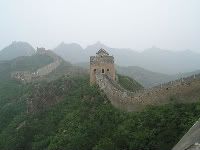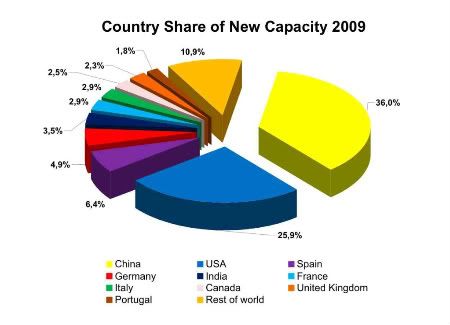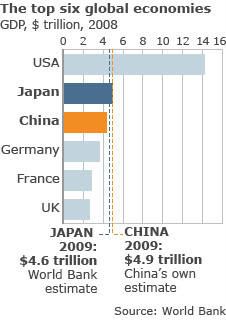Powerhouse China and The Renewable Energy Race — By Guest Blogger Kathy

And indeed they are rushing ahead. From nowhere, they are now the third largest producer in the wind power market and one of the fastest-growing in domestic wind installations. For the fourth consecutive year, says the World Wind Energy Report 2009, China doubled its wind installations, which is no small feat. While the U.S. was number one in world total installed capacity with China number two, China had the most share of new capacity in 2009 (13,800 MW to America’s 9,922 MW). The following chart, courtesy the World Wind Energy Association (WWEA) illustrates new capacity in 2009.
By 2009, 82 countries were employing wind energy but China and the U.S. are by far the largest markets for new wind capacity. Offshore wind is another story. China installed its first major offshore wind farm near Shanghai and is 9th in the world as far as total offshore capacity – the U.S. is not on the list.
As far as other clean tech, China is the current world leader in solar photovoltaic manufacturing and production, though they judged large-scale solar too expensive for their own domestic uses. China provides more than 40% of the world’s solar photovoltaics. They have the world’s largest market for solar hot water; more than 10 percent of Chinese households rely on the sun to heat their water. And they are number one in hydropower.
7.5 percent of China’s energy and 17 percent of its electricity comes from renewable energy, with targets for 15 percent and 21 percent of the same by 2020, says Worldwatch Institute. China has tremendous power needs, with a large and growing population. They estimate electricity consumption will increase by 15% per year. The standard of living is rising and so will demand for appliances and energy in the world’s most populous country.
Without question, China is a powerhouse. The World Bank says China contributed one-third of global economic growth in 2004, and that they expect their economy to continue to be robust this year. Its economy expanded 8.7% in 2009, and it is on course to overtake Japan’s 2nd spot, says BBC news (January 21, 2010). China was hit with the recession in 2008 but quickly rebounded, in part by a stimulus plan, including a focus on renewable energy. The chart below shows the top six economies from the BBC, sourced from the World Bank.
China’s renewable industries have provided 1.12 million jobs in 2008, and jobs are apparently rising by 100,000 per year, says the Chinese Renewable Energy Industries Association.
In his State of the Union address, President Obama gave notice that the U.S. is falling behind other countries on energy, especially China. “I do not accept a future where the jobs and industries of tomorrow take root beyond our borders,” he said. But many think China will prevail. The massive focus, deployment and development of clean energy is staggering.
Renewable Energy Law
China introduced their Renewable Energy Law (REL) of the PRC at the beginning of 2006, and results are already evident. It has proven to be very influential. The REL commits to provide special funding, financial incentives and discount lending to stimulate renewable energy development. Feed-in tariffs are part of the plan.
Joel Eisen at the University of Richmond reports, “A feed-in tariff says that if you generate renewable energy you get paid for it. You can get paid up front for the price of wholesale energy. The system focuses on paying the generator a specific price for the amount generated. It has nothing to do with demand.” (Joel Eisen, Professor of Law, University of Richmond. China’s Renewable Energy Law: the “Green” to China’s “Black”. January 29, 2010).
Eisen says that China has also set up direct subsidies to people who generate renewable energy, which had enormous impacts on increasing wind and solar manufacture since 2006.
Amendments were made to the Renewable Energy Law in December 2009 which are in effect April 1, 2010, showing China’s continued attention to the industry. The amendments involve better planning systems and access to transmissions and pricing for China’s utility companies.
Green and Black
China is apparently a quite polluted nation. 70% of electricity has been generated from coal. Large cities have serious air pollution problems and water is also polluted. While it is difficult to obtain specifics from a nontransparent insular country, it seems that China has recognized both the opportunity of employing green tech but also the necessity. And they are putting everything behind the effort.
The vice director of the National Energy Administration, Liu Qi, says, “No matter what happens with international climate change negotiations, reducing fossil fuel consumption and developing renewable energy will be the best way to ensure a secure energy supply. The target of reducing carbon intensity by 40 to 45 percent in 2020…will depend more on the development of renewable energy.” (UPI. “China plans renewable energy center”. February 10, 2010).
The Grid Problem
A serious challenge to the push, though, has been the grid system. The transmission grids are not ready as fast as the many wind farms are. And some wind farms are being set up in remote areas, where there is in fact more wind resources, but the transmission challenge deepens. China is spending $87 billion by 2020 on smart grid systems. Unlike many countries, they don’t worry about jurisdictions – they can relocate anyone in the way of transmission lines, much like the relocation that occurred for the large hydropower projects.
The government charges a renewable energy fee to all electricity users, which goes to the utility companies to run the grid. This helps make up the cost difference between renewables and cheaper coal.
National Renewable Energy Center
The country announced on February 10, 2010 that they plan to build a national renewable energy center to support the growing sector. It will be responsible for program management, policymaking, operations, database and information platforms as well as an international exchange program. (China Daily. “China draws up plans for national renewable energy center”, by W. Shihong and S. Xiaohua. February 10, 2010). This is another demonstration that green energy is a priority.
Energy is Energy
Interestingly, when it comes to fossil fuels, there does not seem to be the “bad guys vs. good guys” controversy. Ron Pernick and Clint Wilder traveled China a few years back while researching their book Clean Tech Revolution. They noticed that oil and coal folks didn’t disparage the renewable technology, and the renewable guys didn’t talk down fossil fuels. The Chinese mantra seems to be, as Clint Wilder summarized: it’s all energy and we need a lot of it. (Renewable Energy World, “State of the Clean-Tech Union: Troubled Waters Ahead?” by Clint Wilder. Jan 27, 2010).
Competitive Market Prices and Controversy
China’s economies of scale and rise to world leadership in renewable manufacturing help bring down prices. They can offer products at low competitive prices. And it doesn’t hurt that China’s state-owned banks can provide needed financing at incredibly low interest rates.
But the flip side is that some countries and companies are worried the lower price competition could hurt them. In response, the deputy managing director of China’s renewable energy association said, “Every country, including the United States and Europe, wants a low cost of renewable energy. Now China has reached that level, but it gets criticized by the rest of the world.” (New York Times. “China Leading Global Race to Make Clean Energy”, by Keith Bradsher. Jan 30, 2010).
China’s Century?
“It is quite possible that this new decade will decide whether the 21st century will be China’s century, in the way that the 20th century was America’s,” Lou Schwartz wrote on February 26, 2010 (Renewable Energy World Magazine, “China Policy”, February 26, 2010).
Clean tech is the economic future. China seems to understand this. Does the U.S.?
The Worldwatch Institute is an independent research organization recognized by opinion leaders around the world for its accessible, fact-based analysis of critical global issues. The Institute’s three main program areas include Climate & Energy, Food & Agriculture, and the Green Economy.


